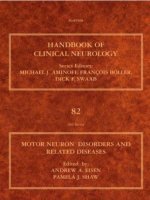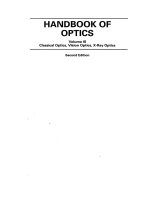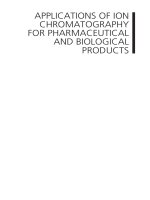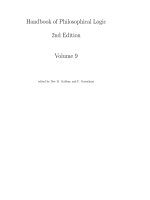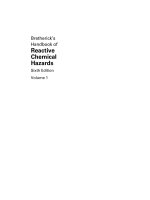Handbook of ion chromatography vol 1
Bạn đang xem bản rút gọn của tài liệu. Xem và tải ngay bản đầy đủ của tài liệu tại đây (7.82 MB, 902 trang )
www.pdfgrip.com
Joachim Weiss
Handbook of Ion Chromatography
www.pdfgrip.com
Further Titles of Interest:
G. Gauglitz, T. Vo-Dinh (Eds.)
Handbook of Spectroscopy
2 Volumes
2003, ISBN 3-527-29782-0
H. Günzler, A. Williams (Eds.)
Handbook of Analytical Techniques
2 Volumes
2001, ISBN 3-527-30165-8
J. S. Fritz, D. T. Gjerde
Ion Chromatography
2000, ISBN 3-527-29914-9
www.pdfgrip.com
Joachim Weiss
Handbook of Ion Chromatography
Third, completely revised and updated edition
Translated by Tatjana Weiss
www.pdfgrip.com
Dr. Joachim Weiss
Dionex GmbH
Am Wörtzgarten 10
65510 Idstein
Germany
All books published by Wiley-VCH are carefully
produced. Nevertheless, author and publisher do
not warrant the information contained in these
books, including this book, to be free of errors.
Readers are advised to keep in mind that
statements, data, illustrations, procedural details
or other items may inadvertently be inaccurate.
Library of Congress Card No. applied for.
British Library Cataloguing-in-Publication Data:
A catalogue record for this book is available from
the British Library.
Bibliographic information published by
Die Deutsche Bibliothek
Die Deutsche Bibliothek lists this publication
in the Deutsche Nationalbibliografie; detailed
bibliographic data is available in the Internet at
<>.
2004 WILEY-VCH Verlag GmbH & Co. KGaA,
Weinheim
Printed on acid-free paper.
All rights reserved (including those of translation
into other languages). No part of this book may
be reproduced in any form Ϫ by photoprinting,
microfilm, or any other means Ϫ nor transmitted
or translated into a machine language without
written permission from the publishers.
Registered names, trademarks, etc. used in this
book, even when not specifically marked as such,
are not to be considered unprotected by law.
Composition pagina media gmbh, Hemsbach
Printing betz-druck gmbh, Darmstadt
Bookbinding J. Schäffer GmbH i. G., Industrieund Verlagsbuchbinderei, Grünstadt
Printed in the Federal Republic of Germany.
ISBN 3-527-28701-9
www.pdfgrip.com
V
Foreword
Over the past few years, ion chromatography has developed into a significant
chromatographic technique for ion analysis within the field of separation science. In addition to publications on the basic principles, it is above all the applied research and the broad applicability of ion chromatography that has made
this technique practically indispensable for the analytical chemist. In view of the
ever-growing number of publications in this field, the numerous international
conferences, as well as the diversity of applications, qualitative, quantitative, and
quality-assured data acquisition become extremely important. It is thus of great
importance to have a fundamental book on ion chromatography, such as this
one by Dr. Joachim Weiss.
Today, in addition to the classical inorganic ions, the field of ion chromatography and the economical significance of this method cover such organic ionic
compounds as organic acids, carbohydrates, and glycoproteins, to name but a
few.
The previous books by Dr. Weiss in the field of ion chromatography are already regarded as classics. This new edition again accommodates all possible
needs in terms of the science and industrial applications involved in this technique.
The volume describes in great detail the theoretical principles, considerations
regarding the separation mechanisms, new stationary phases for anion- and cation-exchange chromatography, ion-exclusion chromatography, and ion-pair chromatography along with new detection methods. Even the statistical data acquisition together with the related fundamental principles, which is indispensable
nowadays for a modern certified analytical laboratory, is outlined, as are special
applications important, for example, to the semiconductor industry.
I trust that the present book, succeeding the previous successful works by Dr.
Joachim Weiss, will once again gain recognition as an important reference work
in science, the laboratory, and industry.
I wish the author and the publishing house much success with this auspicious work.
Innsbruck, January 2004
Dr. Günther Bonn
Professor for Analytical Chemistry
University of Innsbruck (Austria)
www.pdfgrip.com
VII
Table of Contents
Foreword
Preface
V
XIII
Volume 1
1
1.1
1.2
1.3
1.4
1.5
Introduction 1
Historical Perspective 1
Types of Ion Chromatography 3
The Ion Chromatographic System 5
Advantages of Ion Chromatography 7
Selection of Separation and Detection Systems
2
2.1
2.1.1
2.2
2.2.1
2.2.2
2.2.3
2.3
2.4
2.5
Theory of Chromatography 13
Chromatographic Terms 13
Asymmetry Factor As 14
Parameters for Assessing the Quality of a Separation 15
Resolution 15
Selectivity 16
Capacity Factor 17
Column Efficiency 17
The Concept of Theoretical Plates (Van-Deemter Theory) 19
Van-Deemter Curves in Ion Chromatography 24
3
3.1
3.2
3.3
3.4
3.4.1
3.4.1.1
3.4.1.2
Anion Exchange Chromatography (HPIC) 27
General Remarks 27
The Ion-Exchange Process 27
Thermodynamic Aspects 29
Stationary Phases 34
Polymer-Based Anion Exchangers 35
Styrene/Divinylbenzene Copolymers 35
Polymethacrylate and Polyvinyl Resins 47
9
www.pdfgrip.com
VIII
3.4.2
3.4.2.1
3.4.3
3.4.4
3.4.4.1
3.4.4.2
3.5
3.6
3.6.1
3.6.2
3.6.3
3.6.4
3.6.5
3.7
3.7.1
3.7.2
3.7.3
3.7.3.1
3.7.3.2
3.7.3.3
3.7.4
3.7.4.1
3.7.4.2
3.7.4.3
3.7.5
3.8
3.8.1
3.8.2
3.9
3.9.1
3.9.2
3.9.3
3.9.4
3.10
3.10.1
3.10.2
3.10.3
3.10.4
3.10.5
Latex-Agglomerated Anion Exchangers 54
Review of Different Latex-Agglomerated Anion Exchangers 57
Silica-Based Anion Exchangers 86
Other Materials for Anion Separations 86
Crown Ether and Cryptand Phases 86
Alumina Phases 95
Eluants for Anion Exchange Chromatography 98
Suppressor Systems in Anion Exchange Chromatography 103
Suppressor Columns 104
Hollow Fiber Suppressors 108
Micromembrane Suppressors 111
Self-Regenerating Suppressors 115
Suppressors with Monolithic Suppression Beds 120
Anion Exchange Chromatography of Inorganic Anions 121
Overview 121
General Parameters Affecting Retention 123
Experimental Parameters Affecting Retention When Applying
Suppressor Systems 123
Choice of Eluant 124
Eluant Concentration and pH Value 137
Influence of Organic Solvents 144
Experimental Parameters Affecting Retention When Applying Direct
Conductivity Detection 145
Choice of Eluant 145
System Peaks 153
Eluant Concentration and pH Value 156
Polarizable Anions 159
Anion Exchange Chromatography of Organic Anions 168
Organic Acids 168
Polyvalent Anions 184
Gradient Elution Techniques in Anion Exchange Chromatography of
Inorganic and Organic Anions 191
Theoretical Aspects 192
Choice of Eluants 194
Possibilities for Optimizing Concentration Gradients 201
Isoconductive Techniques 204
Carbohydrates 205
Sugar Alcohols 209
Monosaccharides 212
Oligosaccharides 226
Polysaccharides 231
Carbohydrates Derived from Glycoproteins 236
www.pdfgrip.com
IX
240
3.10.5.1
3.10.5.2
3.11
3.12
3.13
Compositional and Structural Analysis
Chosen Examples 254
Amino Acids 257
Proteins 267
Nucleic Acids 275
4
4.1
4.1.1
4.1.1.1
4.1.1.2
4.1.1.3
4.1.2
4.1.3
4.2
4.3
4.3.1
4.3.2
4.3.3
4.3.4
4.3.5
4.4
Cation Exchange Chromatography (HPIC) 279
Stationary Phases 279
Polymer-Based Cation Exchangers 280
Styrene/Divinylbenzene Copolymers 280
Ethylvinylbenzene/Divinylbenzene Copolymers 282
Polymethacrylate and Polyvinyl Resins 296
Latexed Cation Exchangers 298
Silica-Based Cation Exchangers 303
Eluants in Cation Exchange Chromatography 308
Suppressor Systems in Cation Exchange Chromatography 310
Suppressor Columns 310
Hollow Fiber Suppressors 311
Micromembrane Suppressors 312
Self-Regenerating Suppressors 313
Suppressors with Monolithic Suppression Beds 318
Cation Exchange Chromatography of Alkali Metals, Alkaline-Earth
Metals, and Amines 318
Transition Metal Analysis 325
Basic Theory 326
Transition Metal Analysis with Non-Suppressed Conductivity
Detection 330
Transition Metal Analysis with Spectrophotometric Detection 331
Analysis of Polyamines 344
Gradient Techniques in Cation Exchange Chromatography of
Inorganic and Organic Cations 349
4.5
4.5.1
4.5.2
4.5.3
4.6
4.7
5
5.1
5.2
5.3
5.4
5.5
5.6
5.7
5.8
Ion-Exclusion chromatography (HPICE) 359
The Ion-Exclusion Process 359
Stationary Phases 361
Eluants in Ion-Exclusion Chromatography 365
Suppressor Systems in Ion-Exclusion Chromatography
Analysis of Inorganic Acids 368
Analysis of Organic Acids 372
HPICE/HPIC-Coupling 375
Analysis of Alcohols and Aldehydes 379
366
www.pdfgrip.com
X
5.9
5.9.1
5.9.2
5.9.3
Amino Acid Analysis 382
Separation of Amino Acids 384
Post-Column Derivatizations of Amino Acids
Sample Preparation 391
6
6.1
6.2
6.3
6.3.1
Ion-Pair Chromatography (MPIC) 393
Survey of Existing Retention Models 394
Suppressor Systems in Ion-Pair Chromatography 399
Experimental Parameters that Affect Retention 400
Type and Concentration of Lipophilic Counter Ions in the Mobile
Phase 400
Type and Concentration of the Organic Modifier 403
Inorganic Additives 406
pH Effects and Temperature Influence 408
Analysis of Surface-Inactive Ions 409
Analysis of Surface-Active Ions 424
Applications of the Ion-Suppression Technique 440
Applications of Multi-Dimensional Ion Chromatography on
Multimode Phases 444
6.3.2
6.3.3
6.3.4
6.4
6.5
6.6
6.7
7
7.1
7.1.1
7.1.1.1
7.1.1.2
7.1.2
7.1.2.1
7.1.2.2
7.2
7.2.1
7.2.1.1
7.2.1.2
7.2.1.3
7.2.2
7.3
7.4
7.4.1
7.4.2
389
Detection Methods in Ion Chromatography 461
Electrochemical Detection Methods 461
Conductivity Detection 461
Theoretical Principles 462
Application Modes of Conductivity Detection 469
Amperometric Detection 474
Fundamental Principles of Voltammetry 475
Amperometry 478
Spectrometric Detection Methods 498
UV/Vis Detection 498
Direct UV/Vis Detection 498
UV/Vis Detection in Combination with Derivatization
Techniques 499
Indirect UV Detection 510
Fluorescence Detection 514
Other Detection Methods 521
Hyphenated Techniques 522
IC-ICP Coupling 523
IC-MS Coupling 530
Index
I1
www.pdfgrip.com
XI
Volume 2
8
8.1
8.2
8.3
8.3.1
8.3.2
8.4
8.4.1
8.4.2
8.4.3
8.5
8.5.1
8.5.1.1
Quantitative Analysis
549
8.5.1.2
8.5.2
8.5.3
8.5.3.1
8.5.3.2
8.5.4
8.5.4.1
8.5.4.2
8.5.4.3
8.5.4.4
8.6
8.6.1
8.7
8.7.1
General 549
Analytical Chemical Information Parameters 550
Determination of Peak Areas 551
Manual Determination of Peak Areas and Peak Heights 552
Electronic Peak Area Determination 554
Statistical Quantities 557
Mean Value 558
Standard Deviation 558
Scatter and Confidence Interval 559
Calibration of an Analytical Method (Basic Calibration) 560
Acquisition of the Calibration Function 561
Method Characteristic Parameters of a Linear Calibration
Function 561
Method Parameters of a Calibration Function of 2nd Degree 564
Testing of the Basic Calibration 565
Testing the Precision 566
Homogeneity of Variances 566
Outlier Tests 567
Calibration Methods 569
Area Normalization 569
Internal Standard 570
External Standard 571
Standard Addition 572
Detection Criteria, Limit of Detection, Limit of Determination 574
Determination of Detection Criteria, Limit of Detection
574
The System of Quality Control Cards 578
Types of Quality Control Cards and their Applications 579
9
9.1
9.2
9.2.1
9.2.2
9.2.3
9.2.4
9.3
9.3.1
9.3.2
9.3.3
Applications 587
Ion Chromatography in Environmental Analysis 588
Ion Chromatography in Power Plant Chemistry 626
Analysis of Conditioned Waters 634
Cooling Water Analysis 640
Flue Gas Scrubber Solutions 644
Analysis of Chemicals 648
Ion Chromatography in the Semiconductor Industry 651
High-Purity Water Analysis 652
Surface Contaminations 654
Solvents 658
www.pdfgrip.com
XII
9.3.4
9.3.5
9.4
9.4.1
9.4.2
9.4.3
9.4.4.
9.4.5
9.5
9.5.1
9.5.2
9.6
9.6.1
9.6.2
9.6.3
9.6.4
9.6.5
9.6.6
9.7
9.7.1
9.8
9.9
9.10
9.11
Acids, Bases, and Etching Agents 664
Other Applications 673
Ion Chromatography in the Electroplating Industry 678
Analysis of Inorganic Anions 679
Analysis of Metal Complexes 686
Analysis of Organic Acids 688
Analysis of Inorganic Cations 689
Analysis of Organic Additives 690
Ion Chromatography in the Detergent and Household Product
Industry 697
Detergents 697
Household Products 704
Ion Chromatography in the Food and Beverage Industry 711
Beverages 713
Dairy Products 733
Meat Processing 739
Baby Food 742
Groceries and Luxuries 746
Sweeteners 752
Ion Chromatography in the Pharmaceutical Industry 756
Fermentation 772
Ion Chromatography in Clinical Chemistry 781
Oligosaccharide Analysis of Membrane Coupled
Glycoproteins 797
Other Applications 803
Sample Preparation and Matrix Problems 823
Index
871
www.pdfgrip.com
XIII
Preface to the Third Edition
Precisely ten years have passed since the publication of the second edition of
this book in 1994. Over this decade the method of ion chromatography has
rapidly developed and been further established. One can name the many new
separator columns with partly extraordinary selectivities and separation power in
this connection. Nowadays, new grafted polymers, compatible with large volume
injections, enable ion analysis down to the sub-µg/L range without time-consuming pre-concentration. Of particular importance is the development of continuous and contamination-free eluant generation by means of electrolysis, which
considerably facilitates the use of gradient elution techniques in ion chromatography. Furthermore, only de-ionized water is used as a carrier with ion chromatography systems configured for the use of such technology. Along with this
development, hydroxide eluants, which are particularly suitable for concentration
gradients in anion exchange chromatography, are increasingly replacing the
classical carbonate/bicarbonate buffers predominantly used so far. In contrast
to carbonate/bicarbonate buffers, which will still be used for relatively simple
applications, higher sensitivities are now achieved with hydroxide eluants. This
trend is supported by an exciting development of hydroxide-selective stationary
phases. In line with classical liquid chromatography, hyphenation with atomic
spectrometry and molecular spectrometry, such as ICP and ESI-MS, is becoming
increasingly important in ion chromatography, too. The section Hyphenated Techniques underlines this importance. Because carbohydrates, proteins, and oligonucleotides are also analyzed by ion-exchange chromatography, but only carbohydrates were included in the second edition, the sections Proteins and Oligonucleotides have been added in this new edition. In combination with integrated
amperometry as a direct detection method, ion-exchange chromatography also
revolutionized amino acid analysis. Thus, in many application areas ion chromatography has become almost indispensable for the analysis of inorganic and
organic anions and cations.
Since the publication of the second edition, all these developments have made
it necessary to rewrite major parts, such that this third edition can be confidently
regarded as a new text. Almost every chapter has been renewed or significantly
revised. For better clarity, the previous chapter Ion-Exchange Chromatography is
now split into the chapters Anion Exchange Chromatography and Cation Exchange
Chromatography. The remaining structure of this book proved to be of value, and
www.pdfgrip.com
XIV
Preface to the Third Edition
has thus remained unchanged. The sections Carbohydrates Derived from Glycoproteins (Section 3.10.5), Proteins (Section 3.12), Nucleic Acids (Section 3.13), and
Oligosaccharide Analysis of Membrane-Coupled Glycoproteins (Section 9.9) have
been completely rewritten by an expert, Dr. Dietrich Hauffe, to whom I would
like to express my sincere gratitude. The chapter Quantitative Analysis was also
rewritten and expanded with information on validation parameters and quality
control cards. In addition, the chapters on detection and applications were significantly expanded with new material and with numerous practical examples in
the form of chromatograms, while applications of ion chromatography in the
petrochemical industry and in the pulp and paper industry were also added.
The objective for this third edition is the same as for the previous two editions:
The author addresses analytical chemists, who wish to familiarize themselves
with this method, as well as practitioners who employ these techniques on a
day-to-day basis and are looking for a reference book that can help to facilitate
method development and provide an overview on existing applications.
At this point, I would like to express my sincere gratitude to many of my
colleagues in all parts of the world, who contributed their experience and knowledge to the preparation of this third edition. I am particularly grateful to Dr.
Detlef Jensen (Germany) for his willingness to always discuss the various aspects
of ion chromatography and for his valuable suggestions, and to Jennifer Kindred
(Sunnyvale, USA) for her incredible effort, patience, and diligence in editing the
translated manuscript. I would be grateful for any criticisms or suggestions that
could serve to improve future editions of this book.
Finally, many thanks to my wife and children who for quite some time, with
an amazing amount of understanding and tolerance, did not see much of their
husband or dad, who spent many evenings, weekends, and public holidays at
the computer.
Idstein, February 2004
Joachim Weiss
www.pdfgrip.com
1
1
Introduction
1.1
Historical Perspective
“Chromatography” is the general term for a variety of physico-chemical separation techniques, all of which have in common the distribution of a component
between a mobile phase and a stationary phase. The various chromatographic
techniques are subdivided according to the physical state of these two phases.
The discovery of chromatography is attributed to Tswett [1, 2], who in 1903
was the first to separate leaf pigments on a polar solid phase and to interpret
this process. In the following years, chromatographic applications were limited
to the distribution between a solid stationary and a liquid mobile phase (Liquid
Solid Chromatography, LSC). In 1938, Izmailov and Schraiber [3] laid the foundation for Thin Layer Chromatography (TLC). Stahl [4, 5] refined this method
in 1958 and developed it into the technique known today. In their noteworthy
paper of 1941, Martin and Synge [6] proposed the concept of theoretical plates,
which was adapted from the theory of distillation processes, as a formal measurement of the efficiency of the chromatographic process. This approach not
only revolutionized the understanding of liquid chromatography, but also set the
stage for the development of both gas chromatography (GC) and paper chromatography.
In 1952, Martin and James [7] published their first paper on gas chromatography, initiating the rapid development of this analytical technique.
High Performance Liquid Chromatography (HPLC) was derived from the
classical column chromatography and, besides gas chromatography, is one of
the most important tools of analytical chemistry today. The technique of HPLC
flourished after it became possible to produce columns with packing materials
made of very small beads (ഠ 10 µm) and to operate them under high pressure.
The development of HPLC and the theoretical understanding of the separation
processes rest on the basic works of Horvath [8], Knox [9], Scott [10], Snyder [11],
Guiochon [12], Möckel [13], and others.
Ion Chromatography (IC) was introduced in 1975 by Small, Stevens, and Bauman [14] as a new analytical method. Within a short period of time, ion chromatography evolved from a new detection scheme for a few selected inorganic
anions and cations to a versatile analytical technique for ionic species in general.
For a sensitive detection of ions via their electrical conductance, the separator
Handbook of Ion Chromatography, Third, Completely Revised and Enlarged Edition. Joachim Weiss
Copyright 2004 WILEY-VCH Verlag GmbH & Co. KGaA, Weinheim
ISBN: 3-527-28701-9
www.pdfgrip.com
2
1 Introduction
column effluent was passed through a “suppressor” column. This suppressor
column chemically reduces the eluant background conductance, while at the
same time increasing the electrical conductance of the analyte ions.
In 1979, Fritz et al. [15] described an alternative separation and detection
scheme for inorganic anions, in which the separator column is directly coupled
to the conductivity cell. As a prerequisite for this chromatographic setup, low
capacity ion-exchange resins must be employed, so that low ionic strength eluants can be used. In addition, the eluant ions should exhibit low equivalent
conductances, thus enabling sensitive detection of the sample components.
At the end of the 1970s, ion chromatographic techniques were used to analyze
organic ions for the first time. The requirement for a quantitative analysis of
organic acids brought about an ion chromatographic method based on the ionexclusion process that was first described by Wheaton and Bauman [16] in 1953.
The 1980s witnessed the development of high efficiency separator columns
with particle diameters between 5 µm and 8 µm, which resulted in a significant
reduction of analysis time. In addition, separation methods based on the ionpair process were introduced as an alternative to ion-exchange chromatography,
because they allow the separation and determination of both anions and cations.
Since the beginning of the 1990s column development has aimed to provide
stationary phases with special selectivities. In inorganic anion analysis, stationary phases were developed that allow the separation of fluoride from the system
void and the analysis of the most important mineral acids as well as oxyhalides
such as chlorite, chlorate, and bromate in the same run [17]. Moreover, highcapacity anion exchangers are under development that will enable analysis of,
for example, trace anionic impurities in concentrated acids and salinary samples.
Problem solutions of this kind are especially important for the semiconductor
industry, sea water analysis, and clinical chemistry. In inorganic cation analysis,
simultaneous analysis of alkali- and alkaline-earth metals is of vital importance,
and can only be realized within an acceptable time frame of 15 minutes by using
weak acid cation exchangers [18]. Of increasing importance is the analysis of
aliphatic amines, which can be carried out on similar stationary phases by adding organic solvents to the acid eluant.
The scope of ion chromatography was considerably enlarged by newly designed electrochemical and spectrophotometric detectors. A milestone of this
development was the introduction of a pulsed amperometric detector in 1983,
allowing a very sensitive detection of carbohydrates, amino acids, and divalent
sulfur compounds [19, 20].
A growing number of applications utilizing post-column derivatization in
combination with photometric detection opened the field of polyphosphate, polyphosphonate, and transition metal analysis for ion chromatography, thus providing a powerful extension to conventional titrimetric and atomic spectrometry
methods.
www.pdfgrip.com
1.2 Types of Ion Chromatography
These developments made ion chromatography an integral part of both modern inorganic and organic analysis.
Even though ion chromatography is still the preferred analytical method for
inorganic and organic ions, meanwhile, ion analyses are also carried out with
capillary electrophoresis (CE) [21], which offers certain advantages when analyzing samples with extremely complex matrices. In terms of detection, only spectrometric methods such as UV/Vis and fluorescence detection are commercially
available. Because inorganic anions and cations as well as aliphatic carboxylic
acids cannot be detected very sensitively or cannot be detected at all, applications
of CE are rather limited as compared to IC, with the universal conductivity detection being employed in most cases.
Dasgupta et al. [22] as well as Avdalovic et al. [23] independently succeeded to
miniaturize a conductivity cell and a suppressor device down to the scale required for CE. Since the sensitivity of conductivity detection does not suffer from
miniaturization, detection limits achieved for totally dissociated anions and low
molecular weight organics compete well with those of ion chromatography techniques. Thus, capillary electrophoresis with suppressed conductivity detection
can be regarded as a complementary technique for analyzing small ions in simple and complex matrices.
1.2
Types of Ion Chromatography
This book only discusses separation methods which can be summarized under
the general term Ion Chromatography. Modern ion chromatography as an element of liquid chromatography is based on three different separation mechanisms, which also provide the basis for the nomenclature in use.
Ion-Exchange Chromatography (HPIC)
(High Performance Ion Chromatography)
This separation method is based on ion-exchange processes occurring between
the mobile phase and ion-exchange groups bonded to the support material. In
highly polarizable ions, additional non-ionic adsorption processes contribute to
the separation mechanism. The stationary phase consists of polystyrene, ethylvinylbenzene, or methacrylate resins co-polymerized with divinylbenzene and
modified with ion-exchange groups. Ion-exchange chromatography is used for
the separation of both inorganic and organic anions and cations. Separation of
anions is accomplished with quaternary ammonium groups attached to the polymer, whereas sulfonate-, carboxyl-, or phosphonate groups are used as ionexchange sites for the separation of cations. Chapters 3 and 4 deal with this type
of separation method in greater detail.
3
www.pdfgrip.com
4
1 Introduction
Ion-Exclusion Chromatography (HPICE)
(High Performance Ion Chromatography Exclusion)
The separation mechanism in ion-exclusion chromatography is governed by
Donnan exclusion, steric exclusion, sorption processes and, depending on the
type of separator column, by hydrogen bonding. A high-capacity, totally sulfonated cation exchange material based on polystyrene/divinylbenzene is employed
as the stationary phase. In case hydrogen bonding should determine selectivity,
significant amounts of methacrylate are added to the styrene polymer. Ion-exclusion chromatography is particularly useful for the separation of weak inorganic and organic acids from completely dissociated acids which elute as one
peak within the void volume of the column. In combination with suitable detection systems, this separation method is also useful for determining amino acids,
aldehydes, and alcohols. A detailed description of this separation method is given
in Chapter 5.
Ion-Pair Chromatography (MPIC)
(Mobile Phase Ion Chromatography)
The dominating separation mechanism in ion-pair chromatography is adsorption. The stationary phase consists of a neutral porous divinylbenzene resin of
low polarity and high specific surface area. Alternatively, chemically bonded octadecyl silica phases with even lower polarity can be used. The selectivity of the
separator column is determined by the mobile phase. Besides an organic modifier, an ion-pair reagent is added to the eluant (water, aqueous buffer solution,
etc.) depending on the chemical nature of the analytes. Ion-pair chromatography
is particularly suited for the separation of surface-active anions and cations, sulfur compounds, amines, and transition metal complexes. A detailed description
of this separation method is given in Chapter 6.
Alternative Methods
In addition to the three classical separation methods mentioned above, reversedphase liquid chromatography (RPLC) can also be used for the separation of
highly polar and ionic species. Long-chain fatty acids, for example, are separated
on a chemically bonded octadecyl phase after protonation in the mobile phase
with a suitable aqueous buffer solution. This separation mode is known as ion
suppression [24].
Chemically bonded aminopropyl phases have also been successfully employed
for the separation of inorganic ions. Leuenberger et al. [25] described the separation of nitrate and bromide in foods on such a phase using a phosphate buffer
solution as the eluant. Separations of this kind are limited in terms of their
applicability, because they can only be applied to UV-absorbing species.
www.pdfgrip.com
1.3 The Ion Chromatographic System
Moreover, applications of multidimensional ion chromatography utilizing
multimode phases are very interesting, too. In those separations, ion-exchange
and reversed-phase interactions equally contribute to the retention mechanism
of ionic and polar species [26]. These alternative techniques are also described
in Chapter 6.
1.3
The Ion Chromatographic System
The basic components of an ion chromatograph are shown schematically in
Fig. 1-1. It resembles the setup of conventional HPLC systems.
Figure 1-1. Basic components of an ion chromatograph.
A pump delivers the mobile phase through the chromatographic system. In general, either single-piston or dual-piston pumps are employed. A pulse-free flow of
the eluant is necessary for employing sensitive UV/Vis and amperometric detectors. Therefore, pulse dampers are used with single-piston pumps and a sophisticated electronic circuitry with dual-piston pumps.
The sample is injected into the system via a loop injector, as schematically shown
in Fig. 1-2. A three-way valve is required, with two ports being connected to the
sample loop. The sample loading is carried out at atmospheric pressure. After
switching the injection valve, the sample is transported to the separator column by
the mobile phase. Typical injection volumes are between 5 µL and 100 µL.
The most important part of the chromatographic system is the separator column. The choice of a suitable stationary phase (see Section 1.5) and the chromatographic conditions determine the quality of the analysis. The column tubes
are manufactured from inert material such as Tefzec, epoxy resins, or PEEK
5
www.pdfgrip.com
6
1 Introduction
Figure 1-2. Schematic representation of a loop injector.
(polyether ether ketone). In general, separation is achieved at room temperature.
Only in very few cases Ϫ for example for the analysis of long-chain fatty
acids Ϫ an elevated temperature is required to improve analyte solubility. An
elevated column temperature is also recommended for the analysis of polyamines in order to improve peak efficiencies.
The analytes are detected and quantified by a detection system. The performance of any detector is evaluated according to the following criteria:
• Sensitivity
• Linearity
• Resolution (detector cell volume)
• Noise (detection limit)
The most commonly employed detector in ion chromatography is the conductivity detector, which is used with or without a suppressor system. The main
function of the suppressor system as part of the detection unit is to chemically
reduce the high background conductivity of the electrolytes in the eluant, and to
convert the sample ions into a more conductive form. In addition to conductivity
detectors, UV/Vis, amperometric, and fluorescence detectors are used, all of
which are described in detail in Chapter 7.
The chromatographic signals can be displayed on a recorder. Quantitative results are obtained by evaluating peak areas or peak heights, both of which are
proportional to the analyte concentration over a wide range. This was traditionally performed using digital integrators which are connected directly to the analog signal output of the detector. Due to low computer prices and lack of GLP/
GLAP conformity, digital integrators are hardly used anymore. Modern detectors
www.pdfgrip.com
1.4 Advantages of Ion Chromatography
feature an additional parallel interface (e.g., RS-232-C), that enables the connection to a personal computer or a host computer with a suitable chromatography
software. Computers also take over control functions, thus allowing a fully automated operation of the chromatographic system.
Because corrosive eluants such as diluted acids and bases are often used in
ion chromatography, all parts of the chromatographic system being exposed to
these liquids should be made of inert, metal-free materials. Conventional HPLC
systems with tubings and pump heads made of stainless steel are only partially
suited for ion chromatography, because even stainless steel is eventually corroded by aggressive eluants. Considerable contamination problems would result,
because metal ions exhibit a high affinity towards the stationary phase of ion
exchangers, leading to a significant loss of separation efficiency. Moreover, metal
parts in the chromatographic fluid path would make the analysis of orthophosphate, complexing agents, and transition metals more difficult.
1.4
Advantages of Ion Chromatography
The determination of ionic species in solution is a classical analytical problem
with a variety of solutions. Whereas in the field of cation analysis both fast and
sensitive analytical methods (AAS, ICP, polarography, and others) have been
available for a long time, the lack of corresponding, highly sensitive methods for
anion analysis is noteworthy. Conventional wet-chemical methods such as titration, photometry, gravimetry, turbidimetry, and colorimetry are all labor-intensive, time-consuming, and occasionally troublesome. In contrast, ion chromatography offers the following advantages:
• Speed
• Sensitivity
• Selectivity
• Simultaneous detection
• Stability of the separator columns
Speed
The time necessary to perform an analysis becomes an increasingly important
aspect, because enhanced manufacturing costs for high quality products and
additional environmental efforts have lead to a significant increase in the number of samples to be analyzed.
With the introduction of high efficiency separator columns for ion-exchange,
ion-exclusion, and ion-pair chromatography in recent years, the average analysis
time could be reduced to about 10 minutes. Today, a baseline-resolved separation
of the seven most important inorganic anions [27] requires only three minutes.
7
www.pdfgrip.com
8
1 Introduction
Therefore, quantitative results are obtained in a fraction of the time previously
required for traditional wet-chemical methods, thus increasing the sample
throughput.
Sensitivity
The introduction of microprocessor technology, in combination with modern
high efficiency stationary phases, makes it a routine task to detect ions in the
medium and lower µg/L concentration range without pre-concentration. The detection limit for simple inorganic anions and cations is about 10 µg/L based on
an injection volume of 50 µL. The total amount of injected sample lies in the
lower ng range. Even ultrapure water, required for the operation of power plants
or for the production of semiconductors, may be analyzed for its anion and
cation content after pre-concentration with respective concentrator columns.
With these pre-concentration techniques, the detection limit could be lowered to
the ng/L range. However, it should be emphasized that the instrumentation for
measuring such incredibly low amounts is rather sophisticated. In addition, high
demands have to be met in the creation of suitable environmental conditions.
The limiting factor for further lowering the detection limits is the contamination
by ubiquitous chloride and sodium ions.
High sensitivities down to the pmol range are also achieved in carbohydrate
and amino acid analysis by using integrated pulsed amperometric detection.
Selectivity
The selectivity of ion chromatographic methods for analyzing inorganic and organic anions and cations is ensured by the selection of suitable separation and
detection systems. Regarding conductivity detection, the suppression technique
is of vital importance, because the respective counter ions of the analyte ions as
a potential source of interferences are exchanged against hydronium and hydroxide ions, respectively. A high degree of selectivity is achieved by using solutespecific detectors such as a UV/Vis detector to analyze nitrite in the presence
of high amounts of chloride. New developments in the field of post-column
derivatization show that specific compound classes such as transition metals,
alkaline-earth metals, polyvalent anions, silicate, etc. can be detected with high
selectivity. Such examples explain why sample preparation for ion chromatographic analyses usually involves only a simple dilution and filtration of the
sample. This high degree of selectivity facilitates the identification of unknown
sample components.
Simultaneous Detection
A major advantage of ion chromatography Ϫ especially in contrast to other instrumental techniques such as photometry and AAS Ϫ is its ability to simultaneously detect multiple sample components. Anion and cation profiles may be
obtained within a short time; such profiles provide information about the sample
composition and help to avoid time-consuming tests. However, the ability of ion
www.pdfgrip.com
1.5 Selection of Separation and Detection Systems
chromatographic techniques for simultaneous quantitation is limited by extreme
concentration differences between various sample components. For example, the
major and minor components in a wastewater matrix may only be detected simultaneously if the concentration ratio is < 1000:1. Otherwise, the sample must
be diluted and analyzed in a separate chromatographic run.
Stability of the Separator Columns
The stability of separator columns very much depends on the type of the packing
material being used. In contrast to silica-based separator columns commonly
used in conventional HPLC, resin materials such as polystyrene/divinylbenzene
copolymers prevail as support material in ion chromatography. The high pH
stability of these resins allows the use of strong acids and bases as eluants, which
is a prerequisite for the wide-spread applicability of this method. Strong acids
and bases, on the other hand, can also be used for rinsing procedures. Meanwhile, most organic polymers are compatible with organic solvents such as
methanol and acetonitrile, which can be used for the removal of organic contaminants (see also Chapter 9). Hence, polymer-based stationary phases exhibit
a low sensitivity towards complex matrices such as wastewater, foods, or body
fluids, so that a simple dilution of the sample with de-ionized water prior to
filtration is often the only sample preparation procedure.
1.5
Selection of Separation and Detection Systems
As previously mentioned, a wealth of different separation techniques is summarized under the term “ion chromatography”. Therefore, what follows is a survey
of criteria for selecting stationary phases and detection modes being suitable for
solving specific separation problems.
The analyst usually has some information regarding the nature of the ion to
be analyzed (inorganic or organic), its surface activity, its valency, and its acidity
or basicity, respectively. With this information and on the basis of the selection
criteria outlined schematically in Table 1-1, it should not be difficult for the
analytical chemist to select a suitable stationary phase and detection mode. In
many cases, several procedures are feasible for solving a specific separation problem. In these cases, the choice of the analytical procedure is determined by the
type of matrix, the simplicity of the procedure, and, increasingly, by financial
aspects. Two examples illustrate this:
Various sulfur-containing species in the scrubber solution of a flue-gas desulfurization plant (see also Section 9.2) are to be analyzed. According to Table
1-1, non-polarizable ions such as sulfite, sulfate, and amidosulfonic acid with pK
values below 7, are separated isocratically by HPIC using a conventional anion
exchanger and are detected via electrical conductivity. A suppressor system may
9
www.pdfgrip.com
10
1 Introduction
be used to increase the sensitivity and specificity of the procedure. Often, scrubber solutions also contain thiocyanate and thiosulfate in small concentrations.
However, due to their polarizability, these anions exhibit a high affinity towards
the stationary phase of conventional anion exchangers. Three different approaches are feasible for the analysis of such anions. A conventional anion exchanger may be used with a high ionic strength mobile phase. Depending on
the analyte concentration, difficulties with the sensitivity of the subsequent conductivity detection may arise. Alternatively, a special methacrylate-based anion
exchanger with hydrophilic functional groups may be employed. Polarizable
anions are not adsorbed as strongly on this kind of stationary phases and, therefore, elute together with non-polarizable anions. Taking into account that other
sulfur-containing species such as dithionate may also have to be analyzed, a
gradient elution technique has to be employed, which allows all compounds
mentioned above to be separated in a single run utilizing a high efficiency separator column and conductivity detection. However, the required concentration
gradient makes the use of a suppressor system inevitable. Concentration gradients on anion exchangers reach the limit when extremely polarizable anions
such as nitrilotrisulfonic acid have to be analyzed. In this case, ion-pair chromatography (MPIC) is the better separation mode, because organic solvents added
to the mobile phase determine analyte retention.
A second example is the determination of organic acids in soluble coffee.
According to Table 1-1, aliphatic carboxylic acids are separated by HPICE on a
totally sulfonated cation exchange resin with subsequent conductivity detection.
While this procedure is characterized by a high selectivity for aliphatic monocarboxylic acids with a small number of carbon atoms, sufficient separation cannot
be obtained for the aliphatic open-chain and cyclic hydroxy acids that are also
present in coffee. Only after introducing a new stationary phase with specific
selectivity for hydroxycarboxylic acids did it become possible to separate the most
important representatives of this class of compounds in such a matrix. Ionexclusion chromatography is not suited for the separation of aromatic carboxylic
acids, which are present in coffee in large numbers. Examples are ferulic acid,
caffeic acid, and the class of chlorogenic acids. Due to π-π-interactions with the
aromatic rings of the organic polymers used as support material for the stationary phase, aromatic acids are strongly retained and, thus, cannot be analyzed. A
good separation is achieved by reversed-phase chromatography using chemically
bonded octadecyl phases with high chromatographic efficiencies. These compounds are then detected by measuring their light absorption at 254 nm.
Further details on the selection of separation and detection modes are given
in Chapters 3 to 6.
www.pdfgrip.com
1.5 Selection of Separation and Detection Systems
Table 1-1. Schematic representation of selection criteria for separation and detection modes.
Anions
Non-polarizable
ions
Inorganic anions
Carboxylic acids
Sulfonic acids
Fatty acids
> C6
pKa < 7
pKa > 7
Polarizable
ions
Inorganic anions
Carboxylic acids
Sulfonic acids
Fatty acids
< C20
Cations
Non-polarizable
ions
Na+, NH4+, K+
Mg2+, Ca2+
Transition metals
Amines < C6
Polarizable
ions
Aryl amines
Alkyl amines
< C20
Amino acids
pKa < 7
pKa > 7
Inorganic ions
F–, Cl–, SO42– etc.
HPIC
Conductivity detection
or
Amperometric detection
Chelates
Polyphosphates
Polyphosphonates
HPIC
Conductivity detection
UV/Vis detection with
post-column reaction
Organic ions
> C6
Formic acid
Acetic acid
Citric acid
HPIC
MPIC
Conductivity detection
or
UV/Vis detection
Metal complexes
HPIC
MPIC
Conductivity detection
or
UV/Vis detection
Electroactive ions
Organic ions
Mercaptanes
HPIC
MPIC
Amperometric detection
Weak inorganic acids
HS–, CN–, CO2–
3
HPIC
Conductivity detection
or UV detection or
Amperometric detection
Alcohols
Aldehydes
HPICE
Pulsed amperometry
Carbohydrates
HPIC
Pulsed amperometry
Inorganic and
organic ions
Palmitic acid
Stearic acid
Anionic surfactants
I–, SCN–, ClO4–
HPIC
MPIC
Conductivity detection
or
UV detection
Organic ions
Phenols etc.
MPIC
Amperometric detection
or
UV/Vis detection
Alkali metals
Alkaline-earth metals
HPIC
Conductivity detection
Amines < C6
MPIC
HPIC
Conductivity detection
for pKb < 7 or
UV/Vis detection
Transition metals
HPIC
UV/Vis detection
with
post-column raction
Amino acids
HPIC
UV/Vis detection or
Fluorescence detection
with
post-column raction
Amines
Pyrimidines
Purines
MPIC
HPIC
Conductivity detection
for pKb < 7 or
UV/Vis detection
Pulsed amperometry
11

